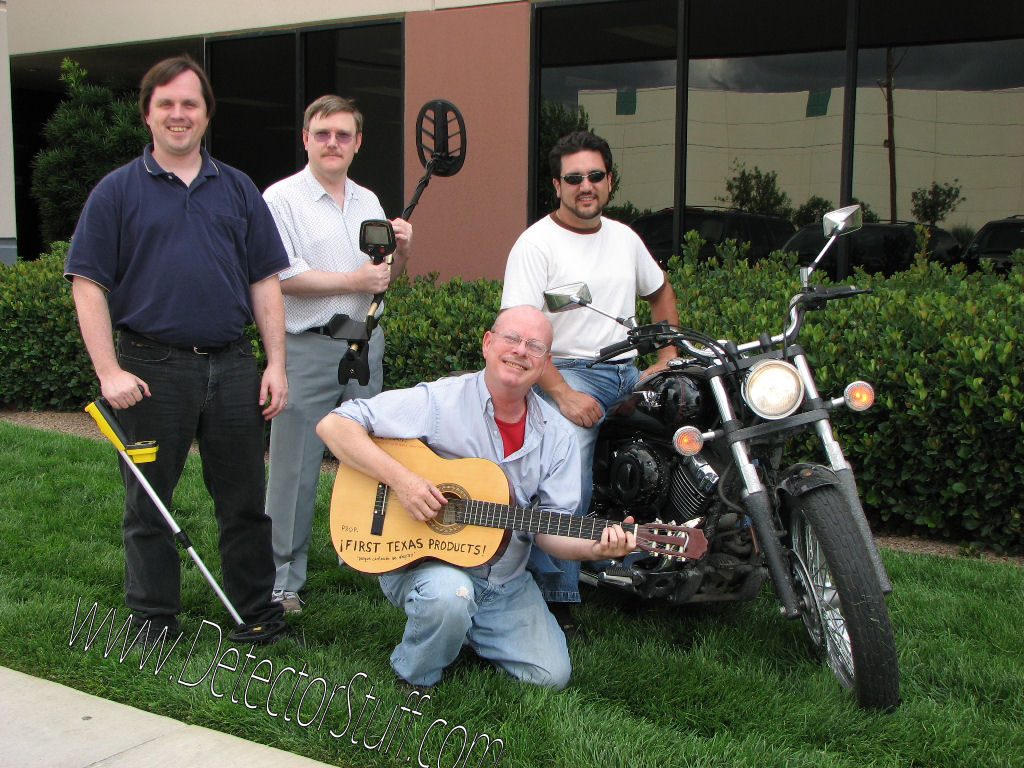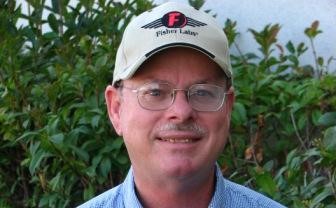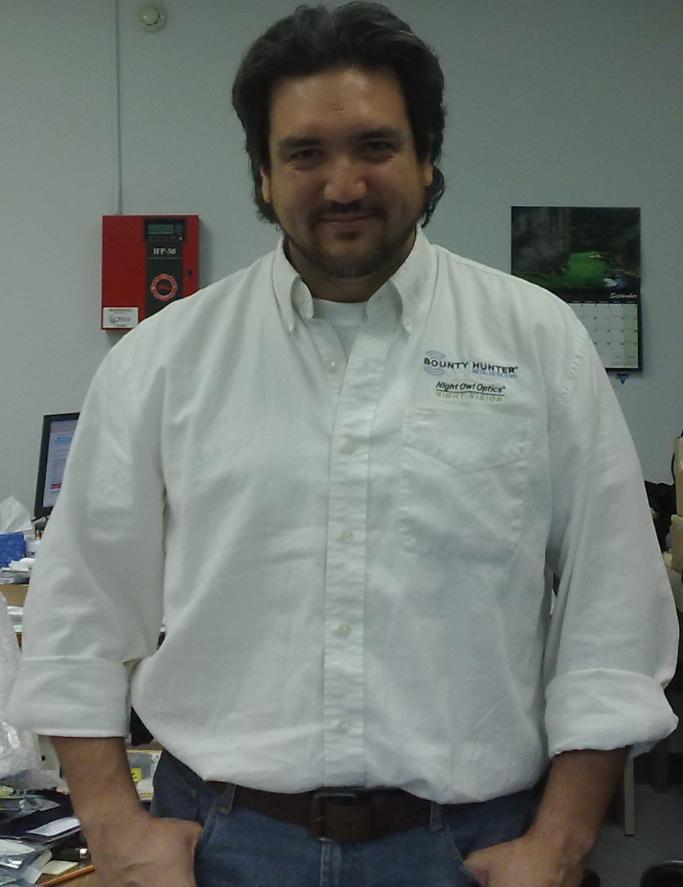 I want to thank the fine folks at White’s, and especially Alan Holcombe and Carl Moreland for helping arrange this interview!
I want to thank the fine folks at White’s, and especially Alan Holcombe and Carl Moreland for helping arrange this interview!
Contributors:
John Earle – Long time White’s Engineer and Loop Guru.
Dan Geyer – Dan worked on the TDI and is White’s PI specialist.
John Plautz – Multifrequency design Engineer
Carl Moreland – Engineering Manager (and owner of the awesome detector tech site Geotech!)
Question 1:
What got you interested in engineering metal detectors?
John Earle: Playing around with them, trying to make one from scratch.
Dan Geyer: During the period of the 1950’s and 1960’s my family was seriously involved with placer mining for gold in the Mother Lode area of California. During that time it was obvious that metal detectors designed for finding gold would be of tremendous value to the prospector, however, there was nothing commercially available that worked satisfactory. When I started into electronic engineering the desire to develop suitable detectors for prospecting was of continuing interest. After a many years of working in the electronics field I finally received the opportunity to work with metal detectors here at Whites. And, it has proven to be the most interesting job in my 47 year career!
John Plautz: I met a technician from White’s about 20 years ago that convinced me metal detector design was more challenging than it appears. He was right!
Carl Moreland: When I was a chip designer for Analog Devices I designed circuits in CAD, but got very little hands-on building and “playing” with circuits. So as a creative outlet, I started building detector circuits on the side, which led to my quest for more technical information, which led to the creation of Geotech, which led to my job with White’s.
Question 2:
What do you feel is the “key” to the success of a new model of metal detector?
JE: How well it works! Or, I could write a book about it. Depth of detection, ground elimination or tracking, are all important issues.
CM: It has to fill a need, do it well, and at the right price. But a good “WOW” factor never hurts.
Question 3:
When designing detectors for the modern hobby market, do you have a “priority” list for the goals of the design? (ie: weight, ergonomics, user interface, depth, etc.)
JE: It’s like politics: Not driven by science but by sales/marketing perceptions of what is needed to “stay in power”, so we usually try to engineer what the company wants next.
CM: Depends on the model. Raw depth is always a goal, as is target ID. But for all models, one thing that is always high on the list is quality. White’s is very proud of the quality coming out of the Sweet Home factory.
Question 4:
Do you guys metal detect as a hobby? If so, what’s your favorite “find” to date?
Also, what are your other hobbies?
JE: My actual use of a metal detector is usually testing in the field. I’m always out of time, so don’t spend a lot of time doing it as a hobby. Other hobbies too numerous to mention. Many stem from a search for truth, especially in the physical sciences. Which leads me to an interest in astronomy (to look for evidence of what the other guys are doing out there), alternative energy conferences that cover over unity, alternative health (since I’m old and just trying to stay alive) and for just plain ego trips, tugboat racing with my friends (we won this year!)
DG: I use a metal detector prospecting for gold in the deserts of Nevada and in the Sierra Nevada Mountains of California. The instruments of today are very effective for locating small grain size pieces of gold as well as larger nuggets in areas that do not have water for placer operations. Today’s detectors are as useful a tool as the gold pans, shovels, and sluice boxes used in the early days of mining.
CM: Yes, I’ve been detecting off-and-on for 30 years, primarily coin hunting, Civil War relics, and beaches. Other hobbies? Way too many, says the wife. Woodworking, backpacking, scuba, various collections (including vintage metal detectors)… and trying to restore a Mustang.
Question 5:
Would you mind giving us a list of detectors you’ve had a hand in developing?
JE: Can’t remember them all. Compass X70, X80, X90, X100, scanners and others. White’s GM3 and 4, Prizms and others, some of which didn’t make it to market, or haven’t yet. Lotsa loops though.
JP: The Surf PI, BeachHunter ID, Sierra Madre, TM808, Pipe & Cable Locator, Bullseye, and Autoscan.
CM: I’ve only worked for White’s for 12 weeks now, so my portfolio is rather thin. For the past 10 years I’ve run the Geotech web site & forums where fellow tech-heads hang out, and I’ve pitched in helping them with their own projects.
Question 6:
Are we about “maxed out” as far as how deep VLF units will go? In your opinion, what’s the biggest obstacle for current technology in achieving increased useable detection depth?
JE: No short answer. Can’t answer it in detail without giving away the GREAT things to come. We will never be “maxed out” on depth.
CM: No, but what is practical? Do people want to dig 15-inch-deep coins? The reality is that depth is limited by soil conditions and trash. For mild soil with little trash, it is possible to design a super-deep VLF (2-foot-deep coins), but there are few sites where it would be useful.
Question 7:
If you had to pick a feature on a detector you’ve helped design, past or present, that you take the most pride in… what would it be?
JE: Coming soon, to a metal detector dealer near you!
CM: Same for me, but with a little more time!
Question 8:
Are TID pulse units the hobby future? Or, what do you think will be the next great advancement in metal detector technology?
JE: Again, confidential. Both induction balance and pulse detectors can be developed with improved performance using the technology available to us today.
DG: I believe that Time Domain Instruments (TDI) will be serious contenders in the future hobby market. Our new TDI detector is a good example of what may be accomplished with this technology. The ability to work in highly mineralized ground that conventional VLF detectors have difficulty in functioning is an extremely valuable attribute! And, the ability of the detector to determine target conductivity has become a very useful tool for the detectorist. This is a technology with a lot of exciting possibilities for the future.
CM: The last couple of years have seen a lot of talk about discriminating PI. Problem is, it’s been mostly talk so far. But I think it is one area where there is a lot of potential for fresh ideas, so I’m pretty excited about it.
Question 9:
Crystal ball time… if you had to take an educated guess, what do you think hobby detecting hardware will be looking like 10 years from now? (Operational and physical)
JE: Small and lightweight user equipment, like Blue Tooth, with the major equipment not on the user rod.
CM: Physically: much the same. The current “styling” works well. I’d like to see discriminating PI, color displays, more analytical power, wireless headphones.
Question 10:
The “halo effect”… fact or fiction?
JE: Fact. How much effect is always a debate
CM: Overstated. Iron, definitely. Gold, no way. Silver & copper, unlikely at any useful level. I’m running a long-term test of the halo effect, so stay tuned.
Question 11:
“Detectable depth of a target cannot exceed the diameter of the coil” ie: 8” coil goes 8” deep. Agree or disagree? (and hopefully, why )
JE: Disagree. Should be 2 times the coil diameter and we are shooting for 3 times (a friend of mine says he’s already there!)
JP: I disagree. There are many things besides size that affect the potential depth of a coil, such as the number of turns on the transmit and receive coils and whether or not the loop is tuned to a specific frequency or is wide band.
CM: Obviously not. It’s pretty easy to make an 8″ coil detect a coin at a foot or more.
Question 12:
What new, top-secret detectors are you currently working on? (HA! Just kiddin’)
JE: Not enough, because we have to take care of Production before we can do the fun stuff.
CM: We are currently working on code name “V”. Too bad you didn’t ask for any details!
*author’s thoughts….I’m kickin’ myself in the back side for NOT asking any details!*
Question 13:
What’s the working environment like at White’s Electronics?
JE: For an old guy like me, the “scenery” is GREAT!
CM: I’ve only been here for 12 weeks. It’s a lot of fun and very relaxed. The best part is having the whole factory at my fingertips. Any time I need anything at all, the folks in the factory bend over backward to help out.
Question 14:
Quite a few of the White’s units utilize a handle/display with electronics/battery housing below pole configuration. Who came up with that design?
JE: I suspect it was Don Dykstra, formerly of White’s and Compass founder.
Question 15:
Do you have a collection of different coins and trash items in your engineering department that you test target ID with? How about test beds/gardens with different soil types? Do you rely heavily on field testers for soil type handling information?
JE: Yes,I have lots of targets. We wish the trash makers would be as consistent as the coin makers! We have test beds, but there is nothing like real, in situ, testing.
JP: Not only do we have a collection of coins and trash targets, we also have hot rocks, ferrites, meteor fragments, gold nuggets, and electronically simulated targets. We do have test beds, some of which are “doped” to have a specific phase and strength. We also have soil samples from around the world, but mostly the USA.
CM: For prototype testing we use our regional distributors and independent testers. This gives us national soil coverage.
Question 16:
Do you follow the online detecting forums and do you feel these help to promote your product and the hobby?
JE: I purposely restrain myself from commenting there since the digression is uncontrollable. And I’d rather not talk about what we are planning on doing in the future.
JP: Yes, the forums are an excellent source of information on what our customers really consider important.
CM: I’m heavily involved in the Internet forums, and have been for over 10 years. I think the forums add tremendously to the hobby, with everything from getting help to organizing hunts.
Question 17:
There’s been a long running hobby rumor that metal detector “power” is restricted by the FCC due to the usage of radio frequencies. True or not?
JE: Again, not as clear as you might think. It is a function of many things including frequency. With low frequency machines, there is almost no limit to power.
CM: There has been a persistent claim of a limit of 100mW. FALSE, no idea where that came from. FCC regulations do include EM radiation limits, but it is not a ‘power’ limit, rather a far-field measurement intended for RF devices. Detectors are not even close. We do have to pay attention to the amount of EMI noise our circuitry generates, however.
Question 18:
Can you explain the advantages vs. disadvantages of both concentric and double D designed coils?
JE: Concentric are more consistent in TID and direction, but have greater ground pickup. DD is famous for less ground response, but has direction idiosyncrasies.
CM: And a double-‘O’ coil is even better than a double-D in bad ground, but they are rarely seen.
Question 19:
Iron separation seems vital nowadays & perhaps more important than depth. Can detectors truly “see thru the iron”, or is “unmasking” best achieved at this point with smaller or DD coils?
JE: “Iron” is never simple either, so it is tough to generalize about it. Small coils always help if the desired target is not directly under the “iron”. If it is, then more sophisticated analysis is needed to separate target from “iron”.
CM: See #25.
Question 20:
It seems specialized detectorists feel frequency/khz is very important now. Is 13khz great for all-around hunting, & why don’t we see say 25khz units for relic hunters?
JE: Low frequency is good for ID’ing big coins. High frequency is better on small items. 25Khz is sensitive to small targets but TID separation of larger things, like coins, is not easy to do reliably above 13 Khz. Hence, the usefulness of a multiple frequency machine.
CM: If you’re talking about CW relics, the 3 B’s – bullets, buttons, & buckles – probably favor a higher frequency since they tend to be low on the conductivity scale. But relic hunters also want raw depth, which favors lower frequency. It’s always a trade-off, eh?
Question 21:
Does White’s have a release “schedule” for new detectors? (ie: trying to release 2 a year, 3 a year, etc.)
JE: No comment.
CM: If we do, I’m not sure we’re meeting it!
Question 22:
Are there any tricks or tips for any of the new White’s detectors you’d like to share with readers?
JE: The more time spent hunting, the better you will become doing it as you learn the detector and the more you will find.
CM: #1: Stick with a particular detector, and learn to “read” its responses. #2: Keep the coil right on the ground and level… I see a lot of people who look like they’re swinging a golf club. #3 Listen for the faint deeeep targets. #4: Use on-line forums for more tips & tricks.
Question 23:
How do you feel about single frequency units VS. multi-frequency when it comes to overall performance? What are the strengths and weaknesses of each?
JE: Multiple frequency is preferred, but expect more battery consumption for equal depth with multiple frequencies.
JP: Multi-frequency units have the advantage of good depth and target ID over a wide range of targets. Single frequency units have the advantage of all of the transmit energy being concentrated at the given frequency, giving the user very good depth for specific types of targets.
CM: In specialized hunting, SF detectors can often beat out MF detectors. That’s because you can highly optimize the SF design for particular situations, But then that same SF design works poorly in other situations. An MF design can be made to work very well in many kinds of hunting, so you can buy one MF detector instead of a half-dozen SF detectors.
Question 24:
What’s the most challenging part of designing metal detectors for the hobby market?
JE: Trying to go deeper and still stay lighter and smaller (and cheaper.)
JP: Improving on existing detector performance – in other words, competing with ourselves.
CM: Coming up with something “new” so it doesn’t look like a re-label job.
Question 25:
There has been a lot of excitement in the hobby due to the release of the new White’s pulse unit, the TDI. Do you have any interesting things to tell us about its capabilities and options?
JE: It must be pretty good if the competition lies about its performance!
DG: After the introduction of our new TDI detector this summer a number of the instruments were used in the Alaskan gold regions with very evident success. A significant number of gold nuggets of all sizes were found in regions that have heavy mineralized ground and “Hot Rocks” that drive regular VLF detectors crazy. The new owners were quite pleased with their results. The TDI’s used on the Civil War battle fields on the East Coast also have found very desirable targets in areas that conventional detectors would not function. The technology used in the TDI’s is showing real results and interesting recoveries.
CM: Although intended as a gold detector, it makes an interesting choice for hunting nail-infested sites. Even today, people reminisce about the old Compass TR machines and their ability to “see through” nails, and wonder why we can’t do that today. The first time I used TDI was at a beach loaded with nails and bottlecaps. I tuned up the TDI and all that junk became literally invisible.
Do you have any parting words for all the Detector Stuff readers and metal detecting fans at large that are following your work?
JE: Keep buying NEW metal detectors, I need the job! (And, sometimes they work better than the old ones.)
CM: White’s engineering is working to improve our efforts to listen to our customers (and even our competitor’s customers!). Please visit the White’s forums (http://forum.treasurenet.com/whites) and click on “Talk To White’s” to get direct access to the engineering team. We want to hear your feedback, gripes, suggestions, and product ideas!
DetectorStuff: Once again THANK YOU for taking the time to share with our readers! I know you Guys are busy building cool new stuff and we sincerely appreciate you “unsung heroes” at the workbenches!
*special thanks to Bill Ladd who contributed quite of few of the interview questions!*



